Artificial intelligence is rapidly permeating all aspects of business, from streamlining daily tasks to influencing strategic decision-making. AI’s growing presence is even evident in the creation of this very report, leveraging generative models to synthesize and present findings.
But how is this transformative technology reshaping customer interactions? How are organizations currently harnessing AI to drive customer success?
To explore these critical questions, we surveyed decision makers in customer experience and related fields, who are involved with customer relations at their organization. This report presents the key insights from our research.
You can download the full report here, or just keep on reading!
Key Findings
- AI penetration into daily work: Professionals are increasingly leveraging AI for tasks such as writing/answering emails (70%), research (69%), and data analysis (65%), freeing up time for strategic initiatives.
- ChatGPT leads in tool adoption: ChatGPT/OpenAI is the most favored AI tool (54%), highlighting its strong market position, while other tools like Gemini/Google AI and Microsoft Copilot are also gaining traction.
- Ease of use is paramount: User-friendly design is the top driver of AI tool adoption (35%), underscoring the importance of intuitive interfaces for successful implementation.
- Chatbots are the most utilized AI technology in CX: 55% of companies are currently using chatbots for customer interactions, demonstrating a focus on automation and enhanced support.
- Many companies have yet to establish formal AI guidelines: While 57% of companies have formal AI guidelines, 37% still lack them, indicating a need for structured governance to ensure ethical and responsible AI use.
- Organizations are eager to increase AI reliance: 56% of respondents believe their company should significantly increase its reliance on AI for customer interactions, demonstrating confidence in AI’s potential to transform CX.
- Customer support and feedback analysis are key areas for increased AI reliance: 43% see the greatest potential for AI in customer support, and 33% in customer feedback analysis.
- Concerns about job displacement persist: While 39% of respondents are not concerned about AI replacing their jobs, 43% express moderate to extreme concern, highlighting the need for proactive communication and upskilling initiatives.
- Data quality and security are top implementation challenges: 40% cite data quality and availability as the primary challenge, followed by privacy and security (39%) and system integration (38%).
The AI Toolkit: How Professionals are Leveraging AI Day-to-Day
The Tools
We begin our analysis by exploring the ground level – the individual professional’s interaction with AI tools. To achieve this, we first asked respondents about their favorite AI tools, probing into the “why” behind their selections. We then investigated the frequent tasks which CX professionals use AI for. This approach allows us to establish a baseline understanding of AI’s current utility before moving on to examine broader organizational strategies and implications.
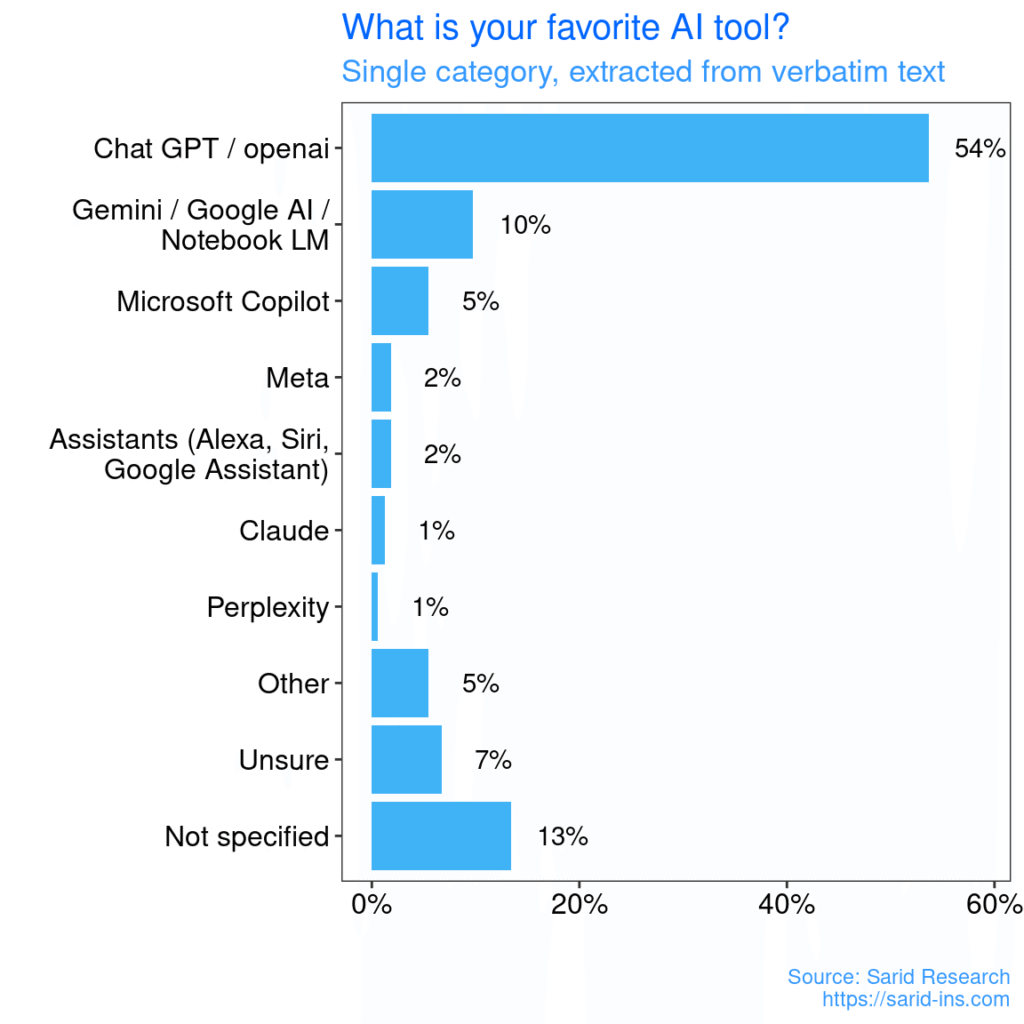
Reasons for AI Tool Preference
As we delve into the intricacies of user preferences within the AI technology landscape, certain characteristics are prominent in driving adoption loyalty. A commanding 35% of respondents prioritize ease of use, UX/UI, and convenience, underscoring the critical role of intuitive design in user satisfaction and retention. Following that, 20% emphasize the accuracy and quality of answers, which aligns with our understanding that performance reliability is paramount in building trust. The range of features, highlighted by 17%, suggests that versatility remains a significant differentiator in a crowded market. Interestingly, 11% of respondents value industry leadership, pointing to the influence of reputation and stability. Moreover, while integrations (8%) and pricing (7%) are less dominant, they are essential considerations for seamless workflow adoption and budget-conscious decision-making.
Customizability and organizational constraints, though noted by a minority, reflect particular niche needs that could be amplified through targeted innovations. This data collectively offers a roadmap for strategic enhancements, guiding decision-makers to focus on user-centric design, robust feature sets, and maintaining a stellar reputation.
Interestingly, some of the “Other” responses included mentions of otter.ai for taking notes during meetings, Guidde for the creation of tutorials, Pi for its emotional intelligence, you.com for its accuracy, and notion.ai for its feature rich interface.
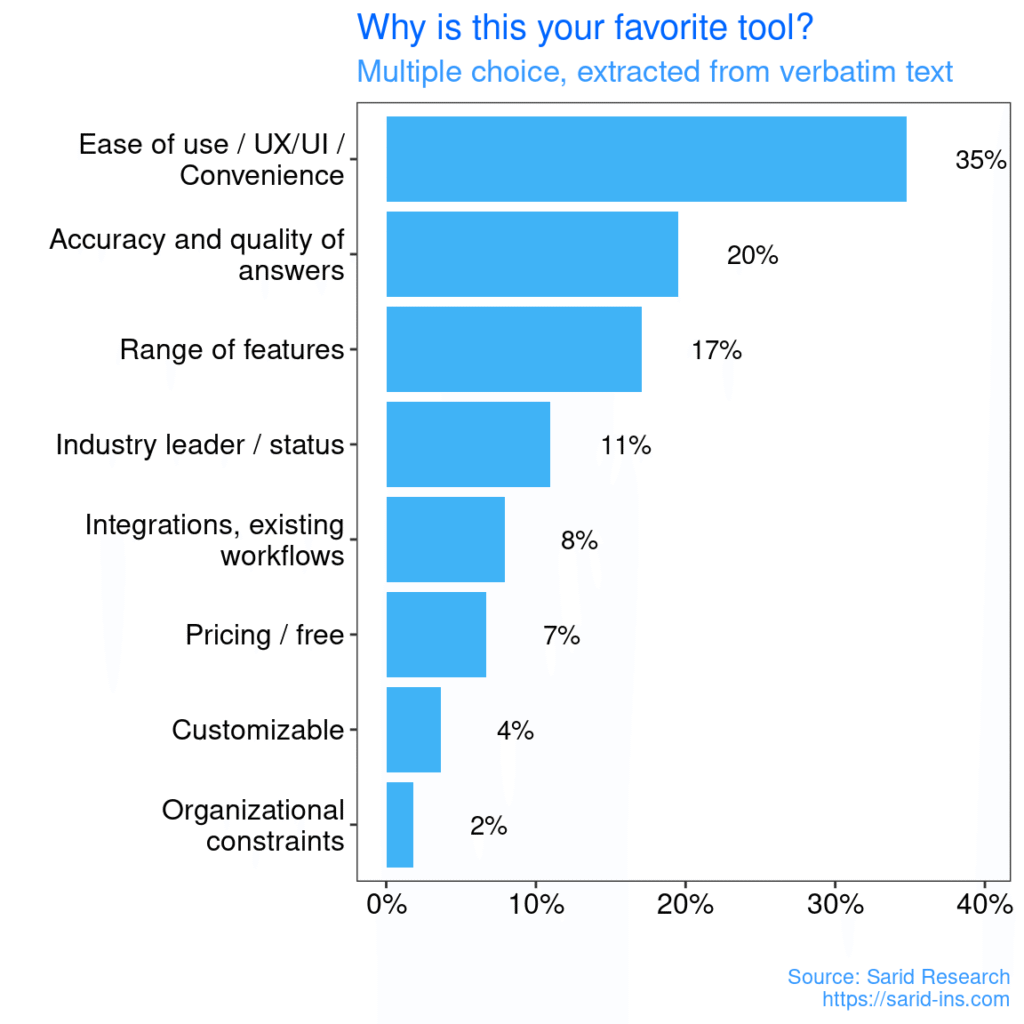
Daily Tasks
Is AI freeing up time for more strategic tasks?
AI has revolutionized our day-to-day tasks. As expected, the leading role of AI is in writing and answering emails (70%) followed closely by using AI to research and retrieve information (69%), Analyzing data (65%), brainstorming ideas (63%) and summarizing documents (60%), freeing up human resources for strategic decision-making. Equally noteworthy despite the surveyed population primarily consisting of customer experience experts, 35% engage in coding or programming tasks. This trend highlights the democratization of coding (“vibe coding”), where AI empowers non-specialists to access and utilize skills traditionally reserved for specialized roles.
These insights suggest a growing accessibility and adaptability of AI, which can facilitate a broader range of tasks beyond conventional boundaries.
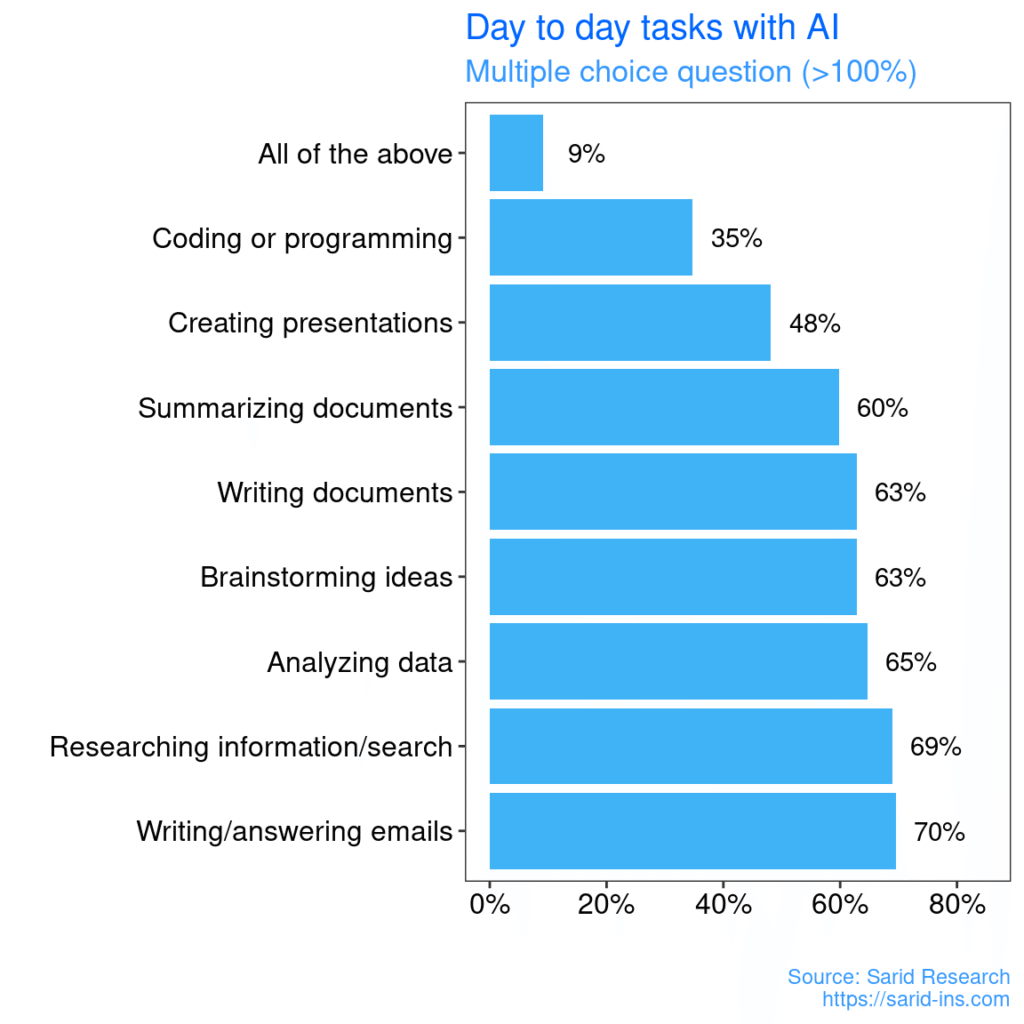
Integrating AI: Technologies, Strategies, and Governance in CX
To understand the practical application of AI in customer experience, we inquired about the specific AI technologies currently in use: “Which of the following AI technologies does your company currently utilize in customer interactions?”.
Current Implementations
Chatbots are leading the adoption race, with 55% deployment, underscoring their effectiveness in enhancing customer interaction and automating support processes. (It’s worth noting that some respondents might have interpreted “customer interactions” broadly to include internal employee support, potentially inflating the chatbot figure.)
Text analysis, including theme and topic extraction, follows closely at 47%, highlighting its role in generating actionable insights from vast data streams. The integration of personalized recommendations at 37% showcases AI’s capability in enhancing customer experiences by tailoring suggestions.
Meanwhile, voice recognition at 33% reflects its growing importance, likely driven by the rise in smart devices and voice-activated platforms. Sentiment analysis and churn prediction, at 26% and 21% respectively, emphasize a strategic focus on understanding customer emotions and retaining clients. However, a notable portion of respondents indicate uncertainty or lack of AI utilization, pointing to untapped potential in driving innovation and competitive advantage through AI solutions.
These findings present a roadmap for expanding AI’s strategic deployment across diverse business functions.
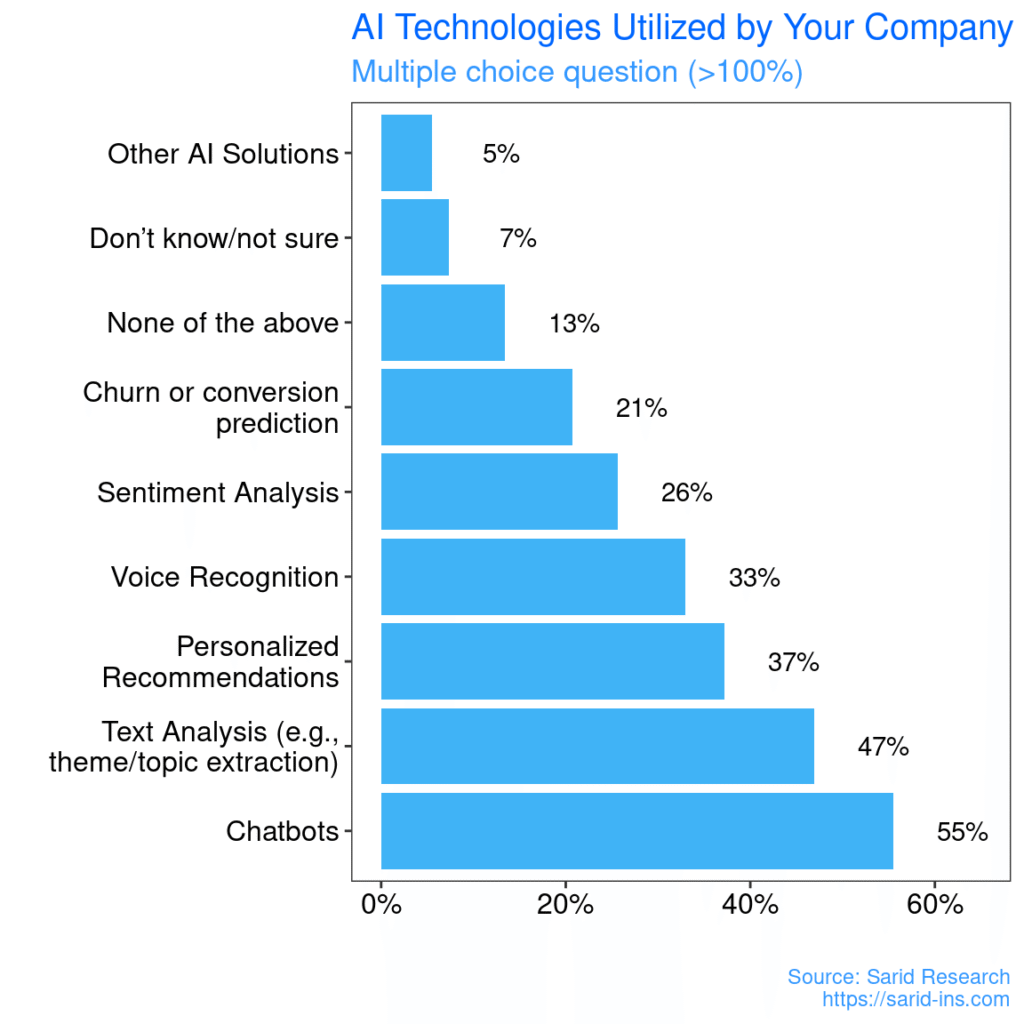
Formal Guidelines
Interestingly, 57% of companies have established formal AI guidelines, showcasing a commitment to ethical and responsible use. However, 37% still lack such guidelines, indicating potential risk and the need for structured governance. The 7% who are unsure suggest gaps in awareness. Clear guidelines are essential to align AI use with best practices and regulatory standards.

The Road Ahead: Increasing Reliance, Potential Impact, and Concerns
Future Reliance
To what extent do you think your company should increase its reliance on AI for customer interactions?
There is a strong inclination towards increasing AI reliance in customer relations, with 56% of respondents advocating for a large to very large extent. This suggests a strategic shift recognizing AI’s potential to enhance customer interactions and efficiency. Meanwhile, 30% moderate their enthusiasm, indicating cautious optimism or a need for more evidence of AI’s impact. Only 14% prefer minimal to no change, highlighting a minority resistant to AI integration. This data underscores a growing confidence in AI’s role in transforming customer relations, urging decision-makers to invest in scalable AI solutions.

In Which Areas?
In which area do you see the most potential for increased AI reliance in customer interactions?
Evidently, 43% of respondents see the greatest potential for AI in enhancing customer support and service, emphasizing AI’s role in streamlining interactions and improving user satisfaction. Following this, 33% recognize the value of AI in analyzing customer feedback and sentiment, indicating a focus on leveraging insights for strategic decision-making. Lesser emphasis is placed on churn prediction and personalized marketing, albeit them being classical machine learning tasks.
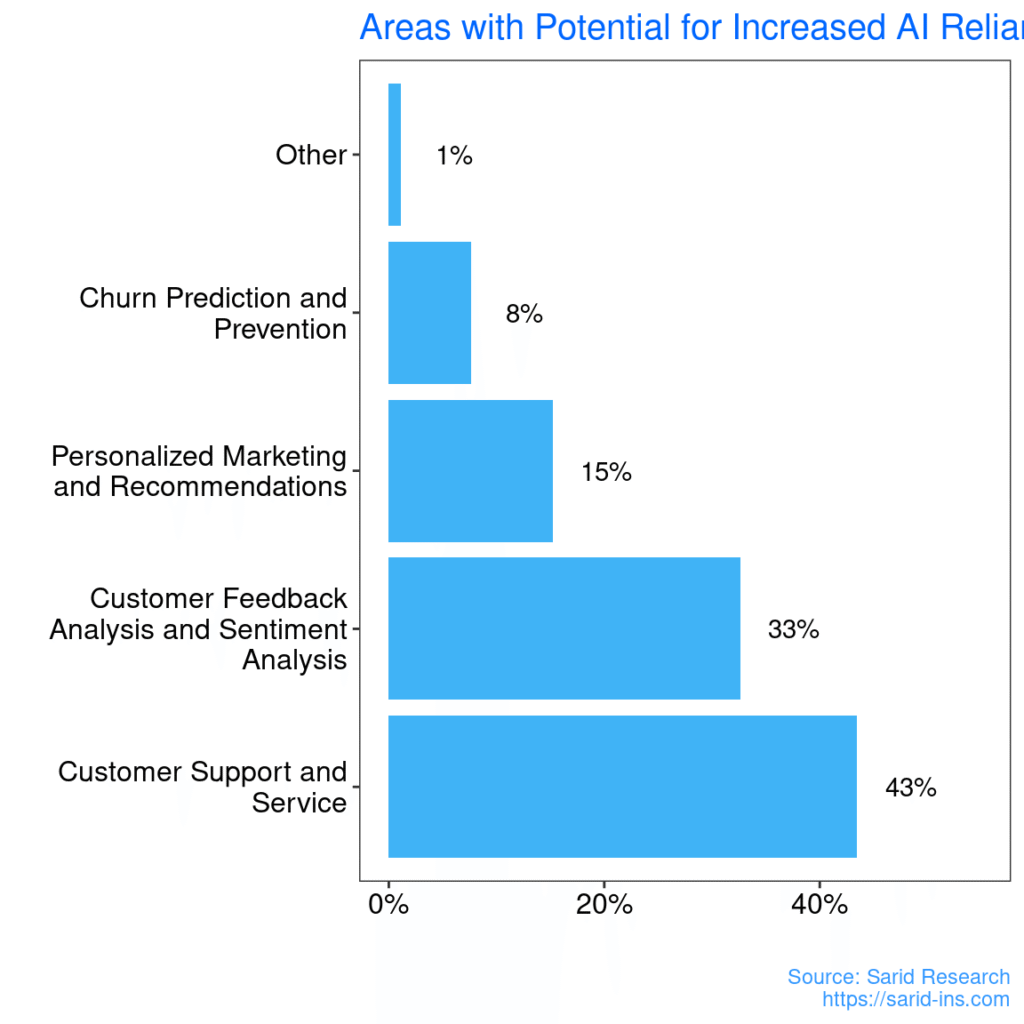
Concerns About AI Replacing Jobs
One prominent concern surrounding the increasing adoption of AI technologies is the fear of job displacement. While some individuals express anxiety about AI replacing their roles, there’s a growing recognition that AI can function as a powerful facilitator, augmenting human capabilities and streamlining workflows. Our survey addressed this concern directly by asking, “On a scale of 1 to 5, how concerned are you that AI technologies might replace your job or parts of it in the future?” The emerging viewpoint suggests that those who proactively adapt and learn to leverage AI tools effectively will likely find themselves becoming more efficient, rather than being replaced by them.

Primary Challenges in AI Deployment
Implementing AI at the organizational level presents a complex set of challenges. These range from fundamental issues of trust in AI’s capabilities to critical concerns around cybersecurity, regulatory compliance, and data privacy. Furthermore, organizations must also consider the significant costs associated with AI model maintenance and operations. The following delves into the primary challenges organizations face when specifically implementing AI to enhance customer experience.
The primary hurdles in implementing AI in customer experience, include data quality and availability (40%) being the top concern, underscoring the need for robust data strategies. Privacy and security (39%) and integration with existing systems (38%) also pose significant challenges, reflecting the complex landscape of AI adoption. Addressing these issues is crucial for fostering customer trust and successful AI integration.

Opportunities and Recommendations
- Prioritize user-centric design: Focus on ease of use and intuitive interfaces to drive AI adoption and maximize user satisfaction.
- Develop comprehensive AI guidelines: Establish clear guidelines for ethical, responsible, and compliant AI implementation.
- Invest in data quality and security: Implement robust data governance strategies to ensure the accuracy, reliability, and security of data used for AI.
- Address concerns about job displacement: Invest in upskilling and reskilling programs to prepare the workforce for the changing role of AI, and communicate clearly about AI’s role in augmenting human capabilities.
- Focus on high-potential areas: Prioritize AI implementation in customer support and feedback analysis to drive significant improvements in CX.
By embracing these opportunities and addressing the associated challenges, organizations can leverage AI to deliver exceptional customer experiences, drive growth, and gain a competitive advantage.
When referencing this report, please cite it as follows: Sarid Research (2025). The State of AI in Customer Experience: Key Trends and Opportunities. Retrieved from https://www.sarid-ins.com.
Who Are We Hearing From? Respondent Profile
We surveyed 164 decision makers (margin of error up to 7.5% with a 95% confidence interval).
To provide context for the survey results, this section outlines the profile of our respondents. We employed a mixed-method approach for data collection, conducted from February to April 2025. This involved utilizing a global online panel, carefully screened to include executives and managers within the customer success, customer experience, and customer service domains. Complementing this, we executed a targeted LinkedIn outreach campaign to engage relevant stakeholders within the CX community (where we also received a minority of responses from additional populations, such as operations, sales, markeing, product, and research). The subsequent charts detail the demographic distribution of respondents, including their positions, roles, and industries.

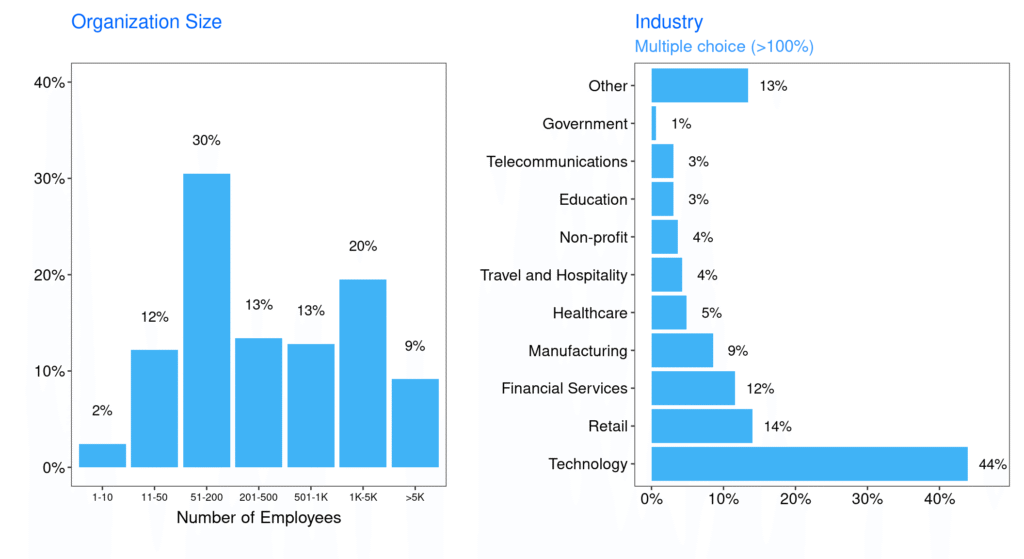
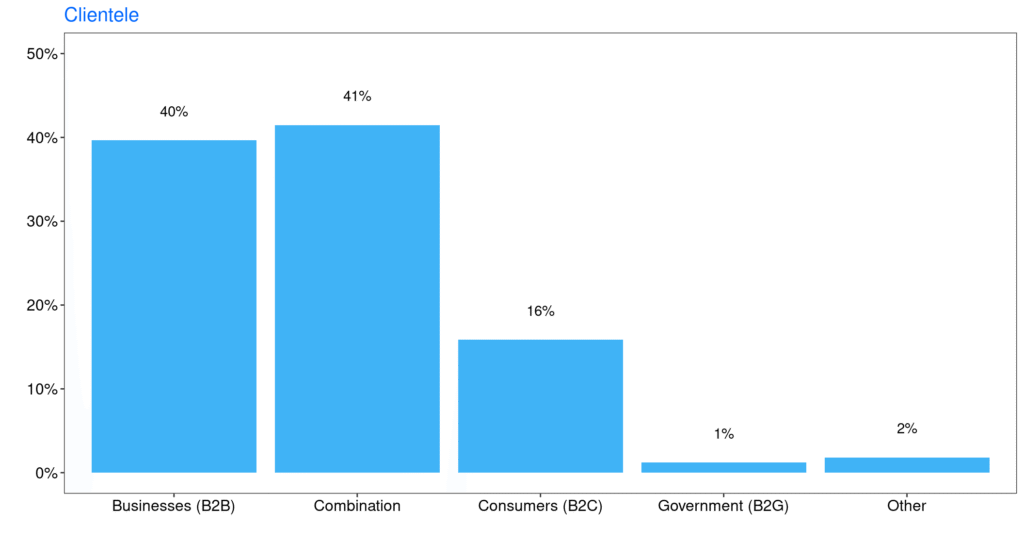
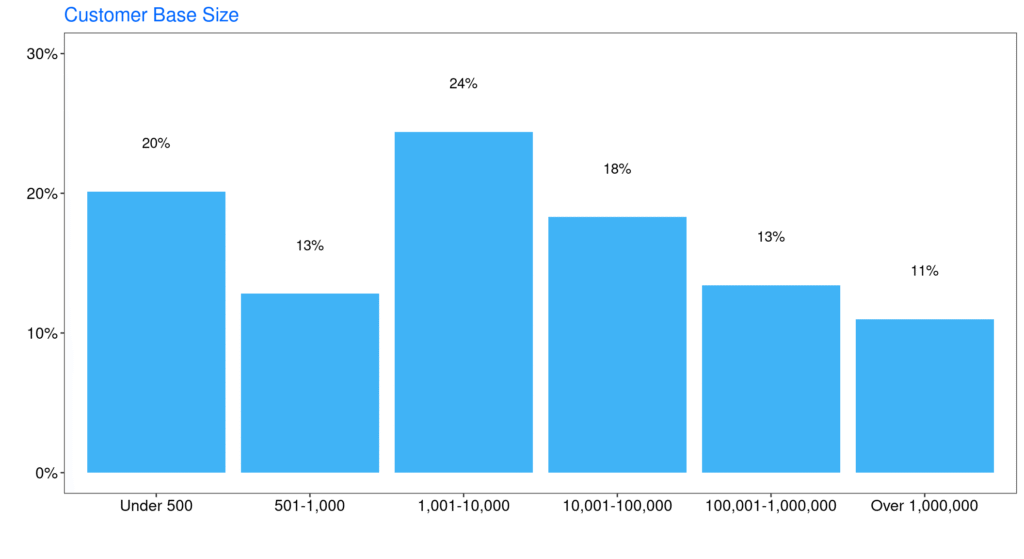
Get in Touch – Sarid Research
We love hearing back! If you found this report interesting or want more information, reach out here, and follow us on LinkedIn.
You can read more about our customer lens solutions here.

